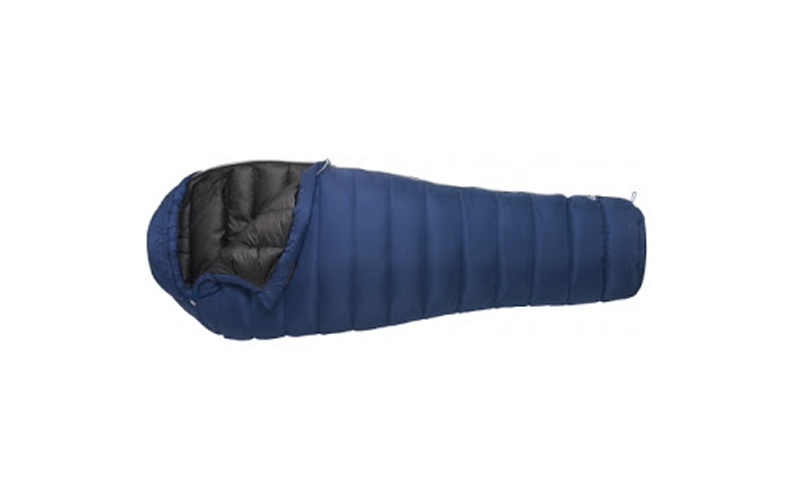How to Fit a Sleeping Bag
The better a sleeping bag fits, the warmer it will be. A properly fitting sleeping bag will wrap around you as snugly as possible, but not fit so tightly that it’s uncomfortable for you to sleep in. The basic idea is simple: You want to minimize the amount of air space around your body. This reduces the amount of air you have to heat up and keep warm, and limits the amount of warmth that gets pushed out when you shift around or roll over inside the bag.
There’s a tradeoff, however, in terms of comfort—which depends largely on your tolerance for being tightly confined inside a sleeping bag. Roomier bags make it easier to roll over and move around, a boon for restless sleepers. They also mitigate the sense of claustrophobia that tight-fitting sleeping bags often create. Roomier bags will be slightly less warm (for the reasons cited above), but a good night’s sleep is vastly more important than maximizing your bag’s warmth at the expense of quality shuteye.
Three Key Measurements to Consider
When it comes to fitting a sleeping bag, there are three important size dimensions to consider. In decreasing order of importance, they are: length, shoulder girth, and hip girth.
Length
First, length. Men’s sleeping bags come in two standard lengths, regular (which fits people up to 6 feet in height) and long (up to 6 feet 6 inches). A short version is sometimes available as well, which usually fits people up to 5 feet 6 inches. Women’s bags also come in a regular and long, though the measurements are different (usually up to 5 feet 4 inches and 5 feet 10 inches, respectively, though these measurements vary slightly by brand and style).
In general, you want to opt for the shortest length sleeping bag that fits you in order to minimize extra room (and maximize warmth) around your feet. (Opting for the shortest bag that fits also saves weight.) The key test is this: When you get inside the sleeping bag, and fully snug up the hood around your head, are your feet pushing against the end of the bag and thus compressing the insulation? If so, the bag is too short and will be less warm due to the insulation being compressed.
That being said, there are some advantages to having extra room below your feet, namely the ability to keep some clothes and/or footwear inside the bag with you to keep them warm. This is most useful on winter camping excursions, where you’ll want to keep your winter boot liners toasty overnight.
Shoulder Girth
Next in importance is shoulder girth, which is the circumference of the sleeping bag across the shoulders. Most men’s sleeping bags feature a shoulder girth somewhere between 60 inches and 64 inches (though some models can be as narrow as 58 inches or as wide as 66 inches). Four inches can make a surprising difference in the roominess of the bag. For most males of standard build, a 60-inch shoulder girth will feel on the snug side while a 64-inch bag will feel pleasantly roomy. Women’s sleeping bags are usually slightly narrower across the shoulders (shoulder girth generally ranges from 56 to 60 inches).
The easiest way to determine your preferred shoulder girth is to test drive several sleeping bags of different dimensions to hone in on the measurement that best balances comfort and warmth for you personally. Note that most ultralight bags tend toward the narrower end of the spectrum, which helps reduce the overall size (and weight) of the bag.
Hip Girth
Lastly, consider hip girth, the circumference of the sleeping bag across the hips. This dimension varies primarily based on whether it’s a men’s or women’s sleeping bag, but is generally consistent across the two gender styles. Most men’s bags feature a hip girth right around 58 inches, while women’s are often a bit wider (up to 60 inches) to better accommodate the slightly wider hips of the female physique. Again, the easiest way to zero in on your preferred hip girth is to try out several different models.
The Hood
The hood of a sleeping bag adds considerable warmth by trapping the heat would otherwise escape from your head. A properly fitting hood will wrap comfortably, and naturally, around your noggin. You shouldn’t feel like you have to cram your head into it to make it work. Once cinched up, it should move with your head as you roll from side-to-side.
So there you go. Sleep warm and comfortable out there!
LEARN MORE ABOUT SLEEPING BAGS FROM THESE RECENT POSTS
- Ultralight Winter Sleeping Bags (2011)
- One-Pound Sleeping Bags (2011)
- Snug up with the right sleep system for winter camping (2011)
- Gear Watch: Selk’bag Sleepwear System (2010)
- Gear Watch: Marmot Plasma Sleeping Bags (2010)
- Ultralight 15-Degree Sleeping Bags (2010)
- Sleeping Bag Warmth Update: European Norm rating s…(2009)
- How to Wash Your Sleeping Bag (2009)
- Drool List: Marmot Sleeping Bags (2009)
- Waterproof Goose Down? (2012)
- Synthetic Insulation: The Long and Short of It (2011)
- Down Time: The story of a miracle material (2011)
- The Incredible Structure of Goose Down (2011)
Equipped is an AMC Outdoors blog, written by Matt Heid.





